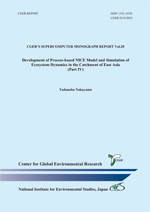NAKAYAMA T.
CGER Reports
CGER’S SUPERCOMPUTER MONOGRAGH REPORT Vol.20
There are diverse and complex water-resources problems in combination with rapid economic growth and serious environmental degradation in East Asia (Fig. 1). For the facilitation of sustainable development, it is necessary to quantify the mechanisms of ecosystem change through an integrated approach, and to carry out an adaptation strategy to ensure sustainable development and to actively recover local natural environments.

This monograph (Part IV, CGER-I114-2014) succeeds a series of reports Vol. 11 (Part I, CGER-I063-2006), Vol. 14 (Part II, CGER-I083-2008), and Vol. 18 (Part III, CGER-I103-2012) published previously. The National Integrated Catchment-based Eco-hydrology (NICE) is a 3-D, grid-based eco-hydrology model combined with satellite imagery, observation data, and statistical analysis, and simulates iteratively nonlinear interactions between hydro-geomorphic and vegetation dynamics (Fig. 2). The NICE model is also coupled with complex subsystems in irrigation, urban water usage, stream junctions, and dams/canals, to develop integrated human and natural systems and to analyze the impact of anthropogenic activity on eco-hydrologic change.

In the current monograph, the author reviews an extension of this advanced process-based model applicable to a continental scale in the Changjiang and Yellow River Basins in China, where two huge national projects, the Three Gorges Dam project (TGD) and the South-to-North Water Transfer Project (SNWTP) are under construction or are almost completed, in order to diminish flood risk and to compensate for the imbalance of environmental resources as much as possible. For example, the author introduces some results on the scenario analysis of conversion from unirrigated to irrigated land in the Yellow River (Fig. 3), the clarification of close interaction between surface water and groundwater in the Changjiang River (Fig. 4), and the prediction of the impact of the TGD and SNWTP on flood occurrence in the middle Changjiang (Fig. 5).



The evaluation of the water-heat-mass cycle in China in this monograph is also important relative to the national security of Japan and international contributions. Such an integrated approach will not only aid an evaluation of the complex processes involved from the view point of hydrologic and biogeochemical cycles, but will also clarify how the substantial pressures caused by such intricately-woven problems can be overcome by effective trans-boundary solutions.


 PDF, 14.0 MB
PDF, 14.0 MB